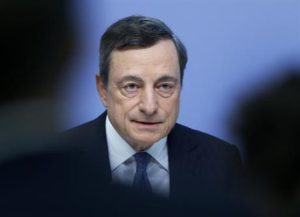WASHINGTON (AP) — The world's key central banks have worked themselves into contortions to try to rev up economic growth, raise inflation and coax
WASHINGTON (AP) — The world’s key central banks have worked themselves into contortions to try to rev up economic growth, raise inflation and coax consumers and businesses to borrow and spend more.
They’ve pumped trillions into financial systems and driven interest rates about as low as they can go — even below zero in Europe and Japan. Yet after several years, the results are … meh.
As central bankers meet this week at an annual conference in Jackson Hole, Wyoming, the global landscape remains bleak. Growth is sluggish. Inflation barely registers. Businesses won’t invest. And consumers remain mostly hunkered down eight years after a financial crisis that jolted central banks to take radical steps in the first place.
Far from stepping up spending, many people and businesses have instead been saving money despite essentially zero interest. Economists warn that the easy-money policies are losing effectiveness over time — and might even make things worse.
“It’s pushing on a string if you’re trying to get people who are already living in a borderline recession economy, who are already up to their eyeballs in debt, to borrow more,” says Mark Blyth, a professor of international political economy at Brown University.
The central banks’ extraordinary efforts weren’t meant to be permanent. They were designed to restore confidence in a banking system that was teetering in 2008 and then to counter the deepest recession since the 1930s.
By all accounts, they managed to ease panic and rescue the world’s advanced economies. But the United States, and especially Europe and Japan, haven’t been able to ignite borrowing and spending and restore their economies to full health.
The International Monetary Fund foresees sluggish growth in each economy this year: 2.2 percent in America, 0.3 percent in Japan and a collective 1.6 percent in the 19 countries that use the euro currency.
Consider inflation: The Federal Reserve, the European Central Bank and the Bank of Japan are all aiming at the same target: 2 percent inflation. They keep missing. Prices are barely rising in Europe and America. They’re falling in Japan. Rising prices are important because they get people to spend to avoid having to pay higher prices later and thereby fuel economic growth.
But consumers and businesses aren’t acting as if they expect prices to rise. They’re acting as if hard times, low prices and cheap loans are here to stay.
In the United States, business investment has fallen for three straight quarters. That’s one reason economic growth has remained subpar since late 2015. American consumers are saving more and charging less on credit cards than they did before the 2007-2009 Great Recession.
Assessing the Fed’s efforts, Charles Sweat, president of First Peoples Bank of Pine Mountain, Georgia, says: “I don’t know it’s done as much to stimulate additional borrowing as it was designed to do.”
Sweat notes that many Georgia households are still recovering from the financial crisis, paying debts and rebuilding savings. He also says regulations enacted after the crisis have made it harder to borrow: Processing a mortgage now takes up to 60 days, twice what it used to.
Still, the Fed may feel confident enough in the economy to resume raising rates when it meets next month. Whatever its other problems, the U.S. economy is generating enough jobs — nearly 2.5 million over the past year — to lower the unemployment rate to a healthy 4.9 percent.
Things look uglier in Europe, where unemployment is stuck at 10.1 percent. European savers are shrugging off super-low — and even negative — interest rates and still socking money away in the bank.
Japan’s central bank imposed a fee on commercial bank deposits in January — a negative interest rate. That bold step was meant to prod banks to lend instead of paying to park their money at the Bank of Japan. No luck. Since January, bank lending in Japan has been growing more slowly than it typically did before the negative rates.
The troubles that ail the world’s biggest economies may be beyond the reach of central banking. They include aging workforces, sluggish worker productivity and a sharp deceleration in China’s mammoth economy, which has shaken financial markets and slowed worldwide growth.
“The Fed can only take things so far,” says Frank Sorrentino, CEO of ConnectOne Bank in Englewood Cliffs, New Jersey. “You look around the globe and you see economies that are not doing well, and it’s putting pressure on the United States.”
He and others say governments must do more by investing in roads, bridges and other infrastructure — moves that could make their economies more efficient and put more people to work. But political gridlock in the United States and debt worries in Europe have paralyzed governments.
“The entire West has forgotten what fiscal policy is,” Brown’s Blyth says.
A new analysis by Standard & Poor’s suggests that rising income inequality may also be diminishing the Fed’s influence.
Lower rates have benefited America’s top earners, who have managed to capitalize on low rates to buy houses or refinance mortgages and enjoy a stock market rally fueled by cheap money.
Conversely, even at low rates, poorer Americans struggle to qualify for mortgages and other loans. And they’re far less likely to own stocks. The result is that it’s hard for the Fed alone to foster a robust recovery.
Some economists warn that easy money is actually causing damage. Unable to earn much on safe investments, some investors are accepting more risk to seek higher returns. Their money can inflate dangerous bubbles in real estate and stock prices.
Many economists say that to restore the economy’s full health, the government needs to spend more or tax less.
“The message is clear,” Scott Minerd, global chief investment officer at Guggenheim Partners, said in a research note. “The current monetary policy regime cannot succeed alone.”
fonte AP economic


